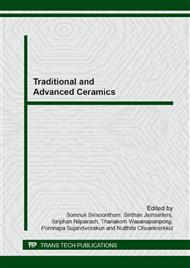p.3
p.8
p.14
p.21
p.26
p.31
p.37
p.41
p.47
Strength Improvement of Porous Ceramics by the Surface Infiltration of Strengthening Materials
Abstract:
One method of improving the strength of porous ceramics is to add Al2O3 in ceramic raw materials and then they must be sintered at high temperature for densification. However, the non-plastic property of Al2O3 leads to a decline in plasticity of clay body, thus severely interfering with forming process. Besides porous ceramics have fine cracks and pores distributed within porous ceramics, these fine cracks on the surface also result in weakening of the sintered body. In this study, we attempted to improve the strength while compensating for the weakness of porous ceramics by the surface infiltration of strengthening materials after the first sintering step at 900°C. MgCl2, Al (NO3)3, and KNO3 were used as surface strengthening materials. The effect of Infiltration factors, solution concentrations (1-3 moles) and infiltration time (1-5 seconds) on the mechanical properties of the sintered body are investigated. When the strength was assessed after the second sintering step at 1250°C, an 30% increase in strength was obtained with Al (NO3)3 infiltrated in a 3 mole solution for 5 seconds. An analysis of the crystal phase of the strengthened body revealed a higher intensity of the mullite phase arising from the infusion of surface strengthening materials. Consequently, the mullite phase led to a higher strength value.
Info:
Periodical:
Pages:
26-30
Citation:
Online since:
April 2014
Authors:
Keywords:
Price:
Сopyright:
© 2014 Trans Tech Publications Ltd. All Rights Reserved
Share:
Citation:


